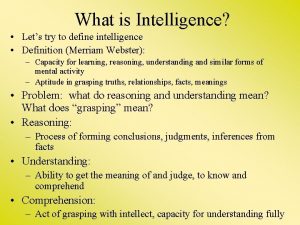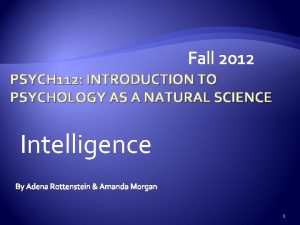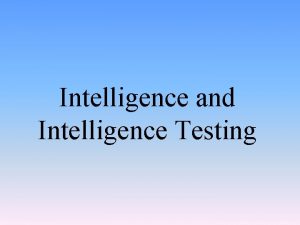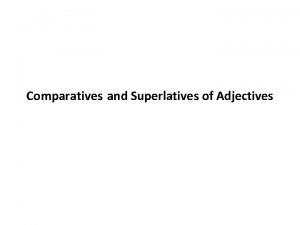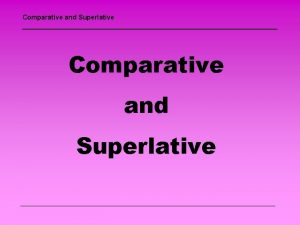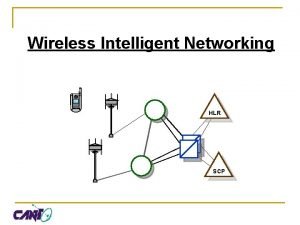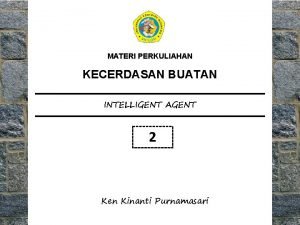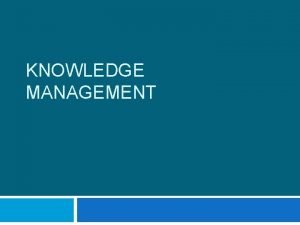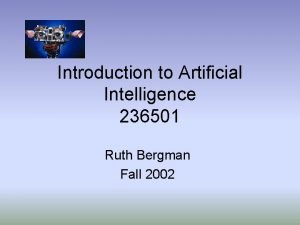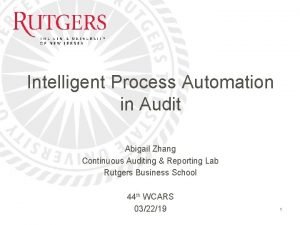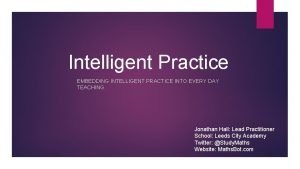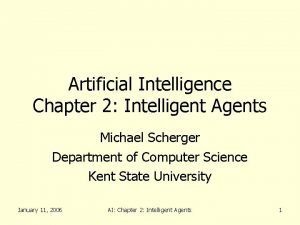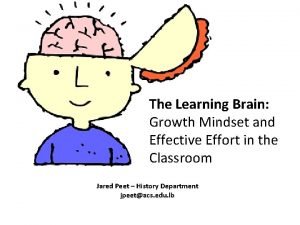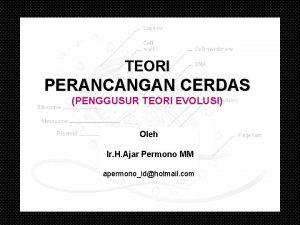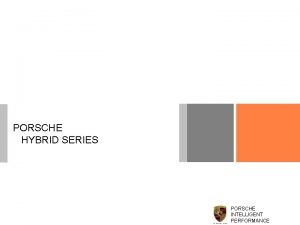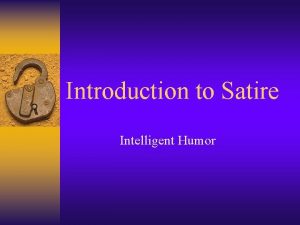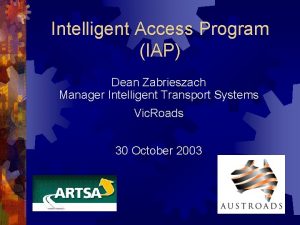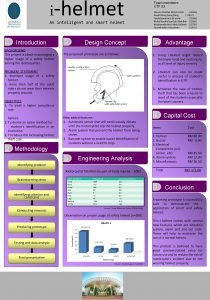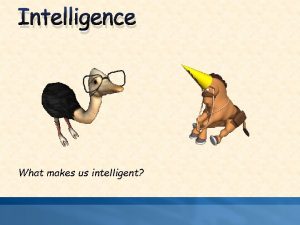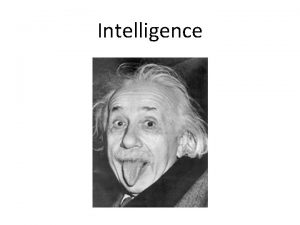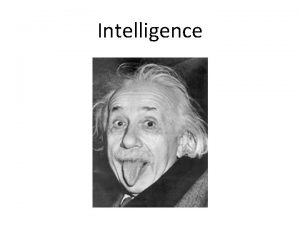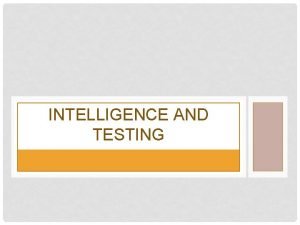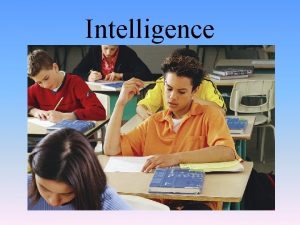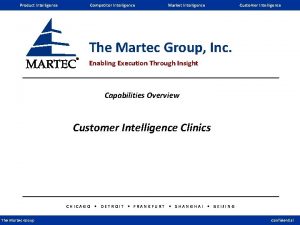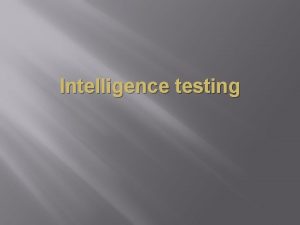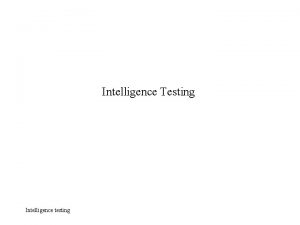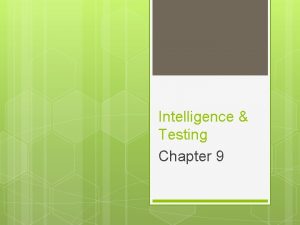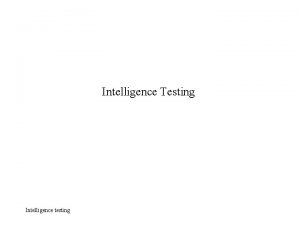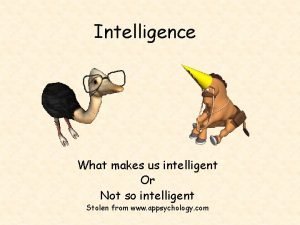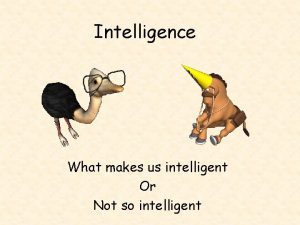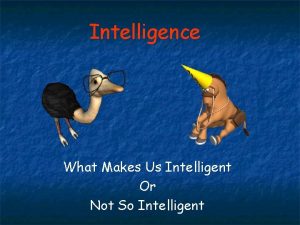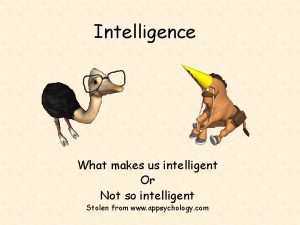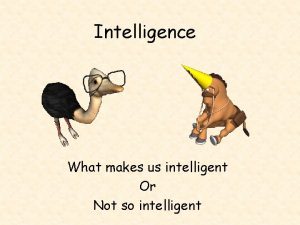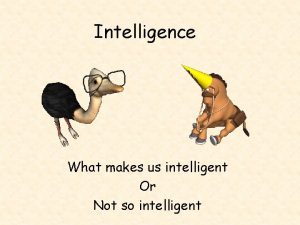Intelligence and Testing What makes us intelligent Or
























































- Slides: 56

Intelligence and Testing What makes us intelligent Or Not so intelligent

Intelligence Testing A term that is used frequently, but often misunderstood is “intelligence. ” Reification: viewing an abstract, immaterial concept as if it were a concrete thing I. Q. is not something that somebody has, it is how they scored on a test Many people disagree about what exactly intelligence is, but most do agree that it is: Relative: defined in relation to the same abilities in a comparison group (usually age) Hypothetically constructed: it is unobservable, but instead inferred from behavior

Intelligence The ability to learn from experience, solve problems, and use knowledge to adapt to new situations. Is socially constructed thus… Can be culturally specific. According to this definition, are both Einstein and Ruth intelligent?

Is intelligence one thing or several different abilities? To find out scientists use FACTOR ANALYSIS: A statistical procedure that identifies clusters of related items on a test. He saw using FA that doing well in one area of a test predicted that you will do well in another. Charles Spearman used FA to discovery his g or (general intelligence).

Measuring Individual Differences Psychology relies heavily on testing individuals, it is part of the foundation for psychological analysis. To be effective, however, strict guidelines must be followed. Validity: Does the test actually measure what we say it does/what we want it to? Ex. Reading on a math test Face validity: Does the test look like it tests what it is supposed to test? Content validity: Each part of the test is representative of the larger body of knowledge.

Measuring Individual Differences Criterion Validity: The behavior (such as college grades) that a test (such as the SAT) is designed to predict Predictive Validity: The success with which a test predicts the behavior it is designed to predict.

Measuring Individual Differences The second part of a credible test is reliability. Reliability: A test yields the same results over time Test-Retest or Split-Half Reliability Reliable, but not valid Not reliable, not valid Reliable and valid

Reliability Extent which a test yields consistent results over time. Spilt halves or test– retest method. Two variables affect IQ stability Interval of time b/t initial test & retest Subjects age

Validity The extent to which a test measures what it is supposed to measure. Content Validity: does the test sample a behavior of interest Predictive Validity: does the test predict future behavior.

Creating Validity and Reliability Most efficient way: standardized test. Standardized test means: The administration and scoring is the same for each test The results of the test can be used to draw a conclusion about the test takers in regard to the objectives of the test. Ex. AP test, S. A. T.

Origins of IQ Testing (1905) Intelligence Test method of assessing an individual’s mental aptitudes and comparing them to those of others, using numerical scores Alfred Binet & Theodore Simon Mental age - what a person of a particular age should know (i. e. -child who does as well as the average 8 -year-old is said to have a mental age of 8) They discovered that by discovering someone’s mental age they can predict future performance.

Binet-Simon. Test Four important distinctions: Scores were interpreted at their current performance Used to identify students in need of help, not label them or categorize them Emphasized that training and opportunity could affect intelligence Was empirically constructed

Coming to America (1915) The idea of IQ testing became popular in America for three reasons: A huge increase in immigration New laws requiring universal education Military assessing new recruits for WWI It created an inexpensive and objective way to separate those could benefit from education or military leadership training and those who needed assistance.

Coming to America… Lewis Terman Used a new scoring scheme introduced by William Stern – the intelligence quotient (IQ). Stanford-Binet American revision of Binet’s original intelligence test IQ = Mental Age/Chronological Age X 100 Avg. score = 100

Problems with the IQ Formula It does not really work well on adults, why? If a 60 year old man does as well as an average 30 year old then his IQ would be 50!! That makes no sense!!!!!

Is intelligence one thing or several different abilities? To find out scientists use FACTOR ANALYSIS: A statistical procedure that identifies clusters of related items on a test. He saw using FA that doing well in one area of a test predicted that you will do well in another. Charles Spearman used FA to discovery his g or (general intelligence).

Terman’s Termites Early ripe-early rot myth. -Wanted to know if high IQ children had intellectual success or failure as adults. (135 and above) According to Terman, “unusually precocious children were more likely to turn out well than poorly later in life” “gifted were taller, healthier, physically better developed, superior in leadership and social adaptability” They are the top 1 percent in intelligence, They should be identified as early as possible in childhood, They should be accelerated through school They should have a differentiated curriculum and instruction, They should have specially trained teachers, They should be viewed as a national resource for the betterment of society

Modern Tests of Mental Abilities David Wechsler (1939) Wechsler Adult Intelligence Scale (WAIS) Consists of subtests Factual, spatial, logic, math Both crystallized & fluid Older than 16 Wechsler Intelligence Scale for Children (WISC)

Wechsler Contributions David Wechsler is credited with two innovations in intelligence testing: Scales give more emphasis to nonverbal reasoning. • New scoring system based on the normal distribution…the % deviation from the norm. • • Example: a person who tests higher than about 98% of his or her peers has an IQ of 130. The mean is


Pros The usage of the bell curve is easier to analyze using data Cons Controversial ideas emerge Black and minority groups in US end up in lower social classes, just as intelligence scores indicate All minority groups (except Asian) score lower

Aptitude v. Achievement Tests Aptitude Measure the effects of learning under uncontrolled conditions designed to predict later performance (college grads) Achievement Given after learning experience to evaluate what an examiner learned Judged on content

Intelligence Testing – Other Issues There is ample evidence that IQ tests are valid measures of academic/verbal intelligence, but they do not tap social or practical intelligence. IQ scores are correlated with occupational attainment, but doubts have been raised about how well they predict performance within a specific occupation. IQ tests are not widely used in most non. Western cultures.

Figure 9. 9: Intelligence as a predictor of job performance. Based on a review of 425 studies, Schmidt and Hunter (2004) report that the correlation between general mental ability and job performance depends on the complexity of the job. As jobs become more complicated, intelligence becomes a better predictor of performance. Schmidt and Hunter conclude that these correlations show that IQ tests can be valuable in hiring decisions. However, as the text explains, some other experts have reservations about using intelligence tests in employee selection. (Based on data from Schmidt & Hunter, 2004)

l a m r o N Judging A “normal curve” is applied to test to determine establish “norms. ” A normal range for IQ scores is 85115 68% of population

Extremes of Intelligence The 7 Year old surgeon-Akrit Jaswal

Mild Classification 55 -70 6 th grade level Capable of living independently Vast majority Moderate 40 -55 2 nd grade level Severe 25 -40 Needs constant supervision Can perform basic self care Profound Below 25 Very limited ability to learn Simple tasks only

Degrees of Intellectual Developmental Disorder

Individual Differences Intellectual developmentally delayed Former assessment: IQ below 70 Current: mental functioning and individuals' functional skills in their environment As a result, a person with an unusually low IQ may not be considered intellectually disabled Adaptive behavior is severely below appropriate age Present before age 18 Causes Biological High % attributed to genes Down syndrome, FAS Environment Exposure to toxins (mercury, lead) Poor nutrition Lack of mental stimulation Hollow children

Biological – Many organic conditions can cause retardation, as 350 biological conditions that can cause mental retardation have been identified. Diagnosticians are, however, only able to pin down a specific organic cause in only about 25% of cases. Environmental – Cases of unknown origin tend to involve mild retardation and are believed to be mainly caused by unfavorable environmental factors. Environmental theories hold that unfavorable environmental factors may contribute to the development of mild mental retardation; things like neglect, inadequate nutrition and medical care, and lower quality schooling.

Giftedness 1. Skills emerge at younger age and develop more quickly • 2. 3. Above IQ 130 (2%) Rage to master • Driven to master domain Marching to own drummer • Learn on own usually • Think/learn differently Factors 1. Nature/genetics Genius 140/145 (1%) It is often thought that geniuses are “odd”, socially awkward, maybe even nutty” Lewis Terman “Termites” Study 1921 - 135 by age 10 (1500 ppl) 97 doctorates, 92 law, 57 medical Gifted were socially well adjusted, often skilled leaders, above avg. height, weight, lower rates of heart disease Not more susceptible but actually more resistant to mental illness 180 and above, however ….

Normal Distribution of IQ Scores

144 + Genius . 13% 130 -144 Gifted 2. 4% 115 -129 Above Avg 13. 59% 100 -114 Higher Avg 34. 13% 85 -99 Lower Avg 34. 13% 70 -84 Below Avg 13. 59% 55 -59 Borderline low 2. 4% 55 - Low . 13%

Downside of IQ Testing Despite its utility, IQ testing had a big downside. Tests ended up reinforcing prevailing prejudices about race and gender. Ignored was the fact that environmental disadvantages limit the full development of people’s intellectual abilities.

Ethnic Similarities and Differences To discuss this issue we begin with two disturbing but agreed upon facts: 1. Racial groups differ in their average intelligence scores. 2. High-scoring people (and groups) are more likely to attain high levels of education and income.

Racial (Group) Differences If we look at racial differences, white Americans score higher in average intelligence than black Americans (Avery and others, 1994). European New Zealanders score higher than native New Zealanders (Braden, 1994). White-Americans Black-Americans Average IQ = 100 Average IQ = 85 Hispanic Americans

Gender Similarities and Differences • Seven ways in which males and females differ in various abilities 1. Girls are better spellers 2. Girls are verbally fluent and have large vocabularies 3. Girls are better at locating objects 4. Girls are more sensitive to touch, taste, and color 5. Boys outnumber girls in counts of underachievement 6. Boys outperform girls at math problem solving, but under perform at math computation 7. Women detect emotions more easily than men do

Test Bias? Tests do discriminate. But some argue that there sole purpose is to discriminate. We have to look at the type of discrimination.

The Question of Bias Aptitude tests are necessarily biased in the sense that they are sensitive to performance differences caused by cultural differences. However, aptitude tests are not biased in the sense that they accurately predict performance of one group over the other.

Test-Takers’ Expectations A stereotype threat is a self-confirming concern that one will be evaluated based on a negative stereotype. This phenomenon appears in some instances in intelligence testing among African-Americans and among women of all colors.

Group Differences in Intelligence Test Scores Asian American highest among ethnic groups Math scores are different across genders and the highest scores are for Asian males. Why? Nature or Nurture

Brain Size and Intelligence Is there a link? Small +. 15 correlation between head size and intelligence scores (relative to body size). Using an MRI we found +. 44 correlation with brain size and IQ score.

Brain Function and Intelligence Higher performing brains use less active than lower performing brains (use less glucose). Neurological speed is also a bit quicker.

Does Intelligence Change Over Time? By age 3, a child’s IQ can predict adolescent IQ scores. Depends on the type of intelligence, crystallized or fluid.

Types of Tests There are two main types of tests: 1. Objective Tests: Tests that have one set answer, that can be scored easily by machine Ex. Multiple choice 2. Subjective Tests: Tests in which individuals are given ambiguous figures or an open ended question which requires some interpretation and analysis. Ex. FRQs Inter-rater reliability

Sample Subjective Test The Rorschach Inkblot Test is one of the most widely known, and inaccurate subjective tests. The following slides are real inkblots from the test that was, at one time, a widely used test. Today, it has lost much, if not all of its credibility in determining intelligence or mental illness.



Sternberg’s Triarchic Theory Modern approach to Gardner Analytical (academic problem solving) Creative (generating novel ideas) Practical (real world application) With this theory, how can any classical intelligence test work?

Multiple Intelligences Howard Gardner Eight independent areas of intellectual competence Visual/Spatial Verbal/Linguistic Logical/Mathematical Bodily/Kinesthetic Musical/Rhythmic Interpersonal Intrapersonal Natural Savant syndrome


Emotional Intelligence (EQ) It is true that not everyone who is intellectually able is going to be successful in life. Know those people who are book smart, but have no common sense? First called social intelligence Awareness & ability to manage one’s emotions, be selfmotivated, be socially skilled Goleman Some studies show EQ to be a greater predictor future success than IQ That sounds nice, but how is it measured?

Intelligence and Creativity: is the ability to produce ideas that are both novel and valuable. Creative people tend to be divergent thinkers. Convergent thinking - thinking that involves following a series of logical steps with the goal of arriving at the “correct” answer. Divergent thinking – thinking used to generate creative ideas by exploring many possible solutions; spontaneous, unorganized thought. Creative people generate new, unexpected ideas first through divergent thought. Ideas are then organized using convergent thought.

Intelligence and Creativity: is the ability to produce ideas that are both novel and valuable. § It correlates somewhat with intelligence. § a high IQ alone does not guarantee creativity § Sternberg identified five components of divergent thinkers and creativity…

Imaginative Thinking: The ability to see things in novel ways. Expertise: A well-developed knowledge base. Creative Environment: A creative and supportive environment allows creativity to bloom. creativity Venturesome Personality: A personality that seeks new experiences Intrinsic Motivation: A motivation to be creative from within.

Emotional Intelligence: Components Component Perceive emotion Understand emotion Manage emotion Use emotion Description Recognize emotions in faces, music and stories Predict emotions, how they change and blend Express emotions in different situations Utilize emotions to adapt or be creative
 Defining intelligence
Defining intelligence Positive vs negative testing
Positive vs negative testing Static testing and dynamic testing
Static testing and dynamic testing A survey of the history of intelligence testing reinforces
A survey of the history of intelligence testing reinforces Audience intelligence testing
Audience intelligence testing Intelligence testing
Intelligence testing Types of reliability
Types of reliability Domain testing
Domain testing Logic based testing in software testing
Logic based testing in software testing Du path testing
Du path testing Globalization testing
Globalization testing Neighborhood integration testing
Neighborhood integration testing Decision table testing in software testing
Decision table testing in software testing Control structure testing in software engineering
Control structure testing in software engineering Decision table testing in software testing
Decision table testing in software testing Decision table testing
Decision table testing Apa itu black box testing
Apa itu black box testing Behavior testing adalah
Behavior testing adalah Decision table based testing in software testing
Decision table based testing in software testing Rigorous testing in software testing
Rigorous testing in software testing Testing blindness in software testing
Testing blindness in software testing Component testing is a black box testing
Component testing is a black box testing Software testing domains
Software testing domains Decision support systems and intelligent systems
Decision support systems and intelligent systems Comparatives clean
Comparatives clean Comparative and superlative high
Comparative and superlative high Conventional computing and intelligent computing
Conventional computing and intelligent computing Any time interrogation call flow
Any time interrogation call flow Vni2140
Vni2140 Intelligent sharing of power
Intelligent sharing of power Intelligent customer routing
Intelligent customer routing Simple reflex agent
Simple reflex agent Intelligent techniques adalah
Intelligent techniques adalah Structure of intelligent agents
Structure of intelligent agents Automatic workload management
Automatic workload management Ace web application firewall
Ace web application firewall Intelligent storage
Intelligent storage Continuous auditing workflow
Continuous auditing workflow Mathsbot differentiated
Mathsbot differentiated Intelligent lectern systems
Intelligent lectern systems Peas outline
Peas outline Faith is the bird that feels the light meaning
Faith is the bird that feels the light meaning Table-driven agent example
Table-driven agent example Disk subsystem
Disk subsystem Ipmi architecture
Ipmi architecture Jared peet
Jared peet Teori perancangan cerdas
Teori perancangan cerdas A smart grid for intelligent energy use
A smart grid for intelligent energy use Porsche swot
Porsche swot Form of intelligent humor
Form of intelligent humor Intelligent web applications
Intelligent web applications Ipmi server management
Ipmi server management Intelligent high beam
Intelligent high beam Intelligent energy insight
Intelligent energy insight Intelligent access program
Intelligent access program Smarthelmet1
Smarthelmet1 Intelligent security graph
Intelligent security graph
